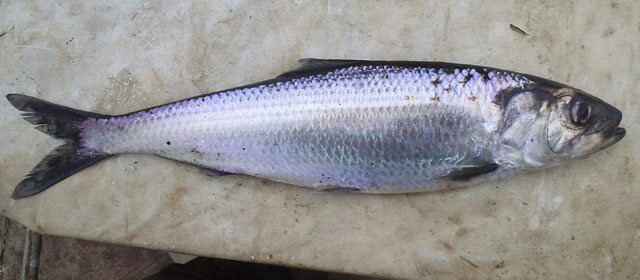| Alosidae (Shads and Sardines) |
| 52 cm SL (male/unsexed); max.weight: 1,200.0 g; max. reported age: 8 years |
|
pelagic-oceanic; freshwater; brackish; marine; depth range 0 - 85 m, anadromous |
| Europe: Caspian Sea from where adults ascend Volga (only few fish enter Ural and Terek) to spawn. Earlier reached upriver up to Kama and Oka system. Migration now blocked by Volgograd dam. May have formed land-lock populations in Volga reservoirs. |
|
Dorsal spines (total): 0-0; Anal spines: 0-0. Body fairly elongate, more `herring-like' than `shad-like'. Total gill rakers 59 to 155 (as in A. caspia), thick, coarse and shorter than gill filaments in some, long, thin and equal to or longer than gill filaments in others (i.e. A. kessleri volgensis). Teeth well developed in both jaws. Other Caspian shads have less than 50 gill rakers, except A. caspia which is deep-bodied. |
| Pelagic at sea, found in a wide variety of habitats. Migrates to middle reaches of large rivers, spawning close to shores in main channel and in almost still water bodies such as river bays and eddies and flood plains, at 4-5 years. Enters rivers with unripe gonads. Some spawn 2-4 seasons with most females dying after spawning. Spawners appear along the coast in March to April, entering rivers April to May when temperature reach about 9°C, peaking at 12-15°C. Duration of spawning originally lasting 30-50 days; it starts in may to August when temperature rises above 15°C and lasts as long as it remains at 15-23°C; it is most intensive between 4-10 p.m. Eggs are bathypelagic. Spent individuals return back to the sea to feed. In autumn, the fish move to the southern part of the sea to overwinter. Juveniles migrate to the sea or estuarine during the first summer until maturity (Ref. 59043). Feeds chiefly on small fishes, less frequently on insect larvae and crustaceans (the latter though being the main food for A. kessleri volgensis) (Ref. 10432). Two subspecies known. The flesh of A. k. kessleri is said to be the tastiest of all Caspian clupeids owing to its high fat content, averaging 18.9% by weight before the spawning period, diminishing to about 1.5% after spawning (Ref. 10432). Impoundment of main rivers significantly reduced available spawning sites and migration routes; heavy overfishing may have caused all population decline during the first decades of teh 20th century. Most spawning grounds were upriver of Volga and now are no longer accessible (Ref. 59043). |
|
Least Concern (LC); Date assessed: 01 January 2008 Ref. (130435)
|
| harmless |
|
Source and more info: www.fishbase.org. For personal, classroom, and other internal use only. Not for publication.

